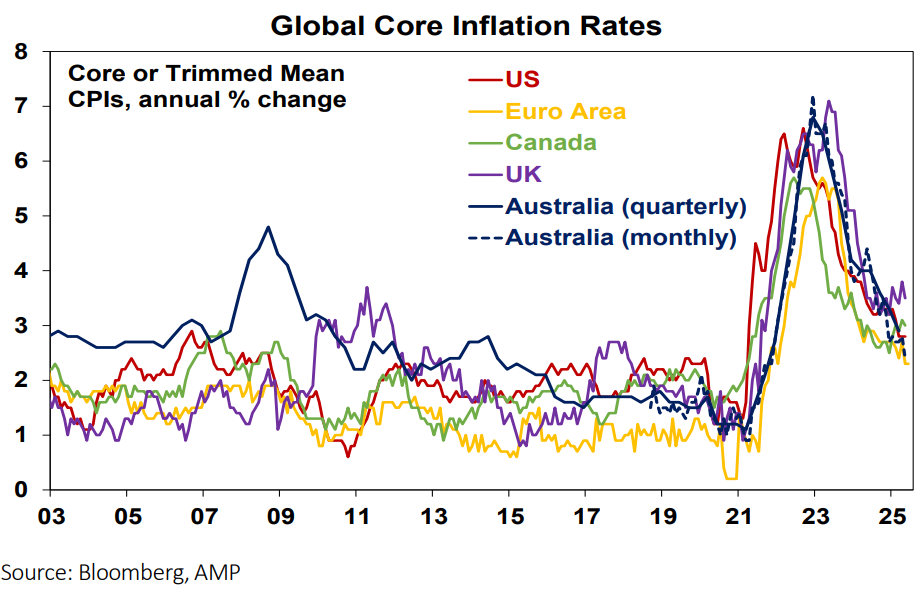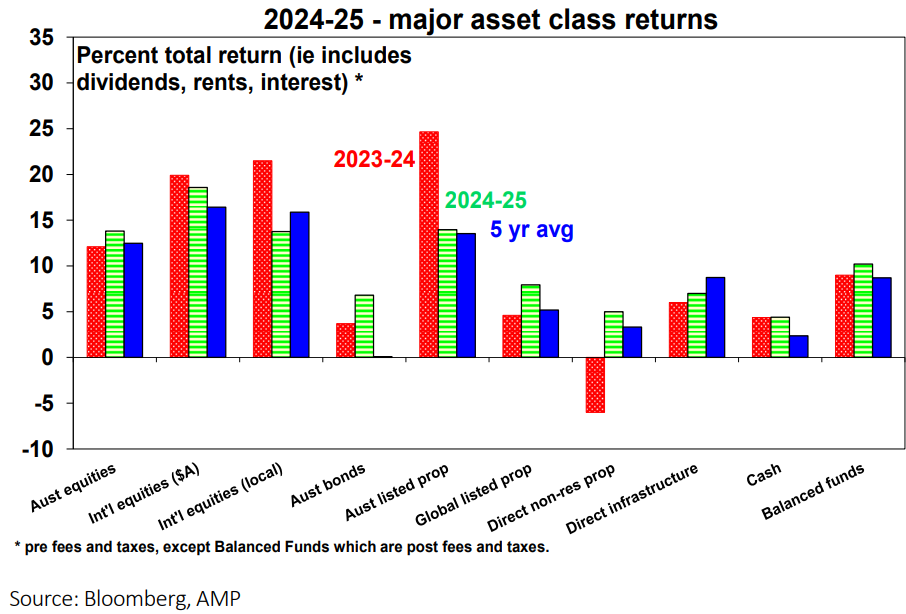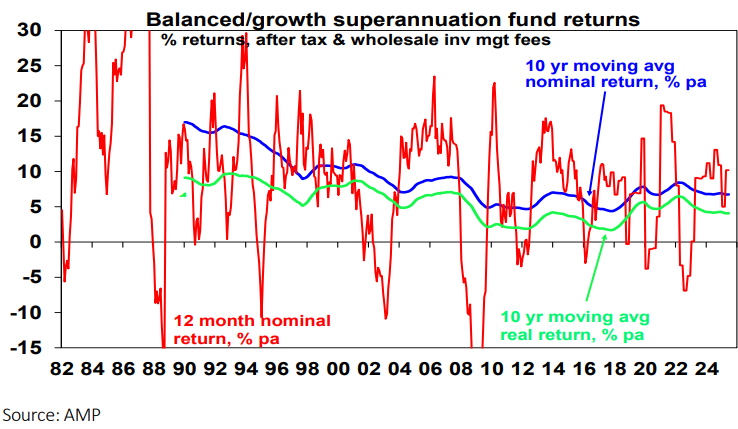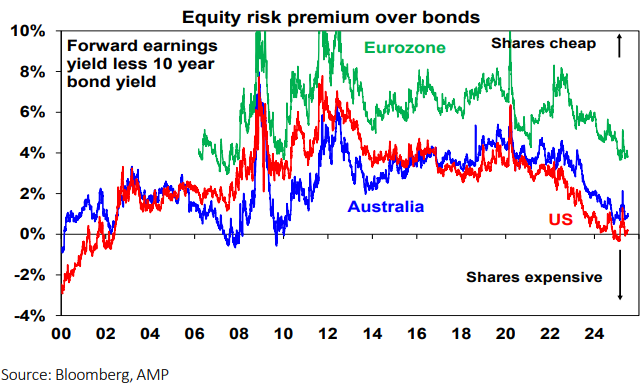2024-25 saw strong investment returns yet again – but is it sustainable?
Investment markets were hit hard in 2022 by surging inflation, interest rate hikes to combat it and fears of recession.However, since then investment returns have been solid as recession was avoided, inflation fell, and central banks cut rates.
- Better than feared economic growth. Recession fears spiked in August last year and April this year with Trump’s tariffs, but growth has turned out better than feared, albeit a little on the soft side.
- Ongoing China worries. These have centred on its property slump and more recently Trump’s tariffs, but its economy has continued to grow around 5% helped by modest policy stimulus.
- President Trump seeking to remake the global order, with tariffs dominating. Initially his election boosted shares to record highs on hopes his policies would be market friendly but the focus on tariffs, attacks on allies, DOGE disrupting public servants, attacks on universities and immigration along with erratic policy making saw a slump in confidence culminating just after his “Liberation Day” tariffs in early April. Since then, confidence has improved as Trump backed down on the tariffs with a pause to allow for trade talks.
- A falling US dollar. 2025 has seen the worst start to a calendar year for the $US since Nixon. This is partly a correction from overvalued levels but appears to have been triggered by worries that: Trump’s policies could dampen US growth; concerns about the sustainability of US public debt; uncertainty about US economic and foreign policy; and some central banks diversifying away from US assets.
- War with Iran involving first Israel and then the US, that briefly threatened global oil supplies but quickly fizzled with oil prices falling.
- A further fall in inflation globally. This includes the US despite tariffs and Australian inflation is at the low end of comparable countries.

- Central banks cutting rates. While the Fed has been on hold, after cutting rates 1% late last year, as it waits to see the impact of Trump’s tariffs, the trend in central bank rates has been down. From February this included the RBA which has cut twice with dovish guidance.
- AI enthusiasm. AI has continued to boost, mainly US, tech stocks with optimism about its productivity enhancing benefits.
Another financial year of strong returns
The result has been another financial year of strong returns from most assets.

- Global shares returned 13.8% in local currency terms over 2024-25, with a fall in the $A boosting this to 18.6% in $A terms. Chinese, US and Eurozone shares outperformed with the US getting a boost late last year and Europe outperforming in the last six months.
- Australian shares also returned 13.8%, helped by the positive global lead and move to lower interest rates with IT, financial and telcos outperforming but resources stocks falling on trade war worries.
- Australian real estate investment trusts returned 14% with global REITs returning 7.9%.
- Unlisted commercial property returns look to have turned positive after the drag from higher bond yields and work from home.
- Australian and global bond returns were strong as yields fell partly on the back of rate cuts.
- Cash returned 4.4% helped by the rate hikes that started in 2022.
- Australian home prices rose just 3.4%, with a soft patch late last year, although there has been a reacceleration since February on the back of rate cuts. Gains were again strongest in Perth, Brisbane & Adelaide.
- Combined, this drove an estimated 10.2% return in average balanced growth superannuation funds.

This makes three financial years in a row of strong (9 to 10%) average super fund returns, after the inflation and interest rate blowout of 2022 last depressed returns.
Given that the historical record warns that a setback is likely sooner or later it’s best to focus on their longer-term average returns which has been 6.7% pa over the last decade or 4.1% pa after inflation. And that’s after fees and taxes, which is pretty good.
Some lessons from 2024-25
The past financial year provided several lessons for investors.
First, in the absence of recession a bear market is shares is unlikely.
Second, falling inflation and interest rates are positive for shares.
Third, Trump still faces constraints from financial markets, US consumers and Republican politicians, and he will back down if financial markets weaken too much.
Fourth, while wars in the Middle East are unsettling for markets, they won’t have any significant impact unless oil supplies are disrupted.
And finally, the last year was another reminder of just how hard it is to time markets. Shares plunged into April leaving sentiment depressed, just when they bottomed only to make new highs in June.
Expect continuing volatility and more constrained returns
There are numerous risks for investment markets in the year ahead:
- Trump’s tariff threat is at high risk of flaring up again - with the 9th of July pause deadline near and more sectoral tariffs set to be announced. More trade deals may soon be announced but the 20% tariff agreed with Vietnam does not augur well and that or even higher could become the norm for some including Europe and Japan. The 10% general tariff on Australian goods is likely to stay.
- US public debt sustainability – concerns on this front could flare up again as the One Big Beautiful Bill (tax cut) Act even with tariff revenue looks set to keep the budget deficit around 6 or 7% of GDP and lead to a further rise in already high level of public debt. This in turn could accelerate the decline in the $US and put upwards pressure on US bond yields. Any move by Trump to undermine the Fed’s independence could accentuate this.
- Geopolitical risks also remain - including around Iran’s nuclear weapons program which look to have been setback but not entirely wiped out, ongoing US/China tensions and the war in Ukraine.
- US share gains have had a high reliance on tech stocks - and in particular Nvidia, which leaves them vulnerable should sentiment towards tech weaken significantly.
- Earnings expectations are at risk - in both the US and Australia with softer than expected economic growth lately.
- Shares are overvalued - trading on high price to earnings multiples and offer a low-risk premium over bonds compared to the last two decades. This is particularly the case for US shares but also to a lesser degree for Australian shares. By contrast Eurozone shares are offering better value. See the next chart. But note that this was also the case a year ago and valuations are a poor guide to timing market moves.

All of which could contribute to a new bout of share market weakness going into the seasonally weak months of August and September.
So, another 15% or so correction is possible.
However, similar things could have been said a year ago and financial year returns turned out to be strong.
While the near-term outlook for shares is still messy, shares should benefit on a 6-12 month view as Trump pivots towards more market friendly policies to help Republicans do well in next year’s midterm elections, the Fed starts cutting rates from September (and possibly this month) and other central banks including the RBA continue to cut rates.
In Australia, we expect the RBA to cut rates four times out to February next year taking the cash rate to 2.85%. All of which should help support economic and profit growth and drive a rising trend in shares.
So, our base case is for continued volatility and more constrained returns after three years of strong gains, but super fund returns are still likely to come in around a reasonable 6-7% over the next 12 months.
Things for investors to keep in mind
Short term forecasting and market timing is fraught with difficulty and it’s best to stick to sound long term investment principles.
Several things are always worth keeping in mind:
- Periodic and often sharp setbacks in shares are normal.
- Selling shares or switching to a more conservative superannuation strategy after falls just turns a paper loss into a real loss.
- When shares and other investments fall in value they are cheaper and offer higher long term return prospects.
- Australian shares still offer an attractive dividend yield.
- Shares and other assets invariably bottom when most investors are bearish.
- And during periods of uncertainty, when negative news reaches fever pitch, it makes sense to turn down the noise around and stick to an appropriate long term investment strategy.

